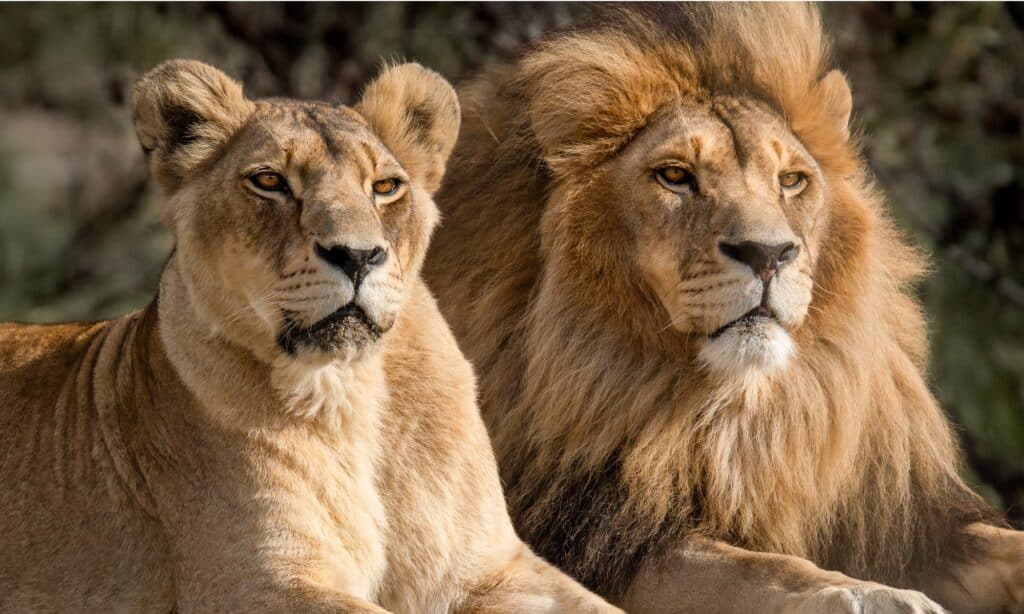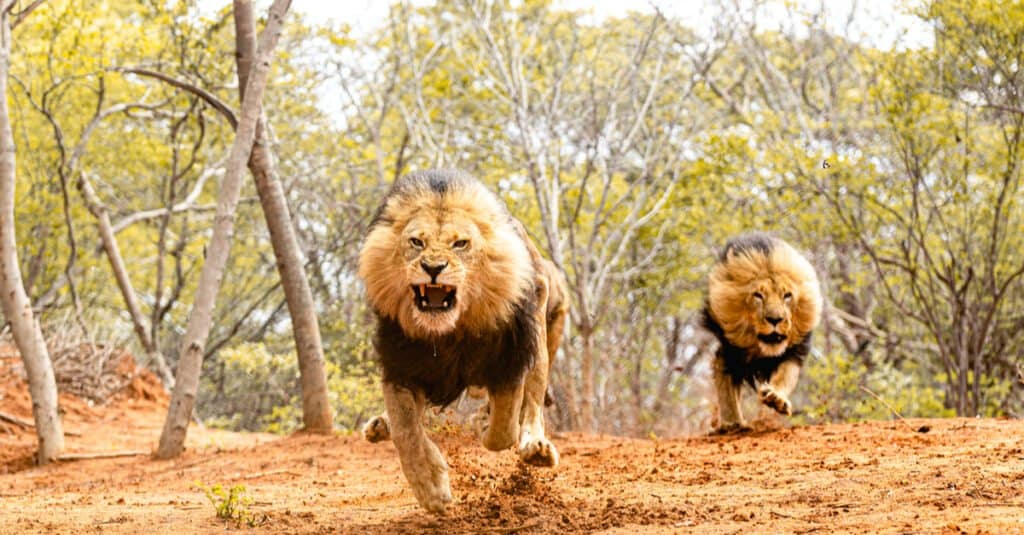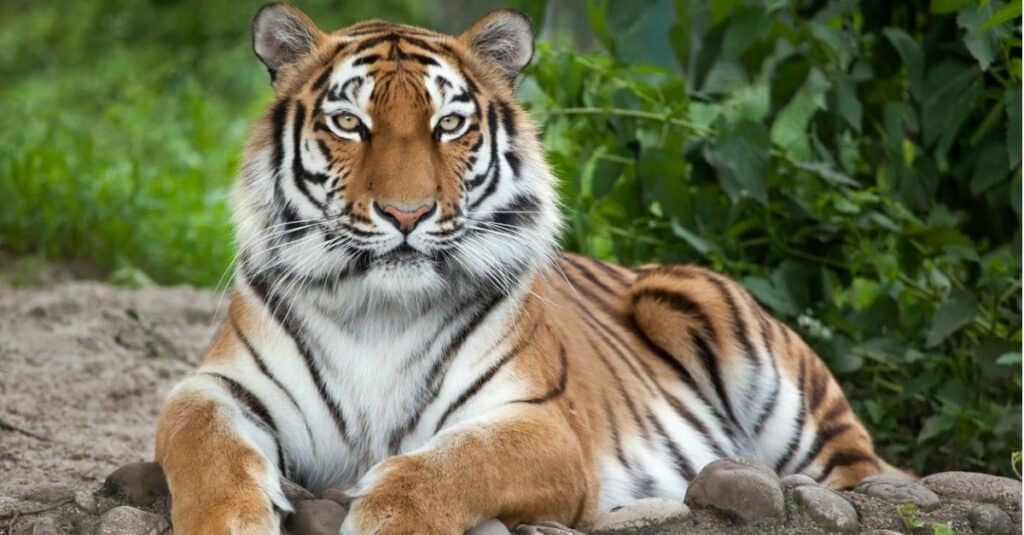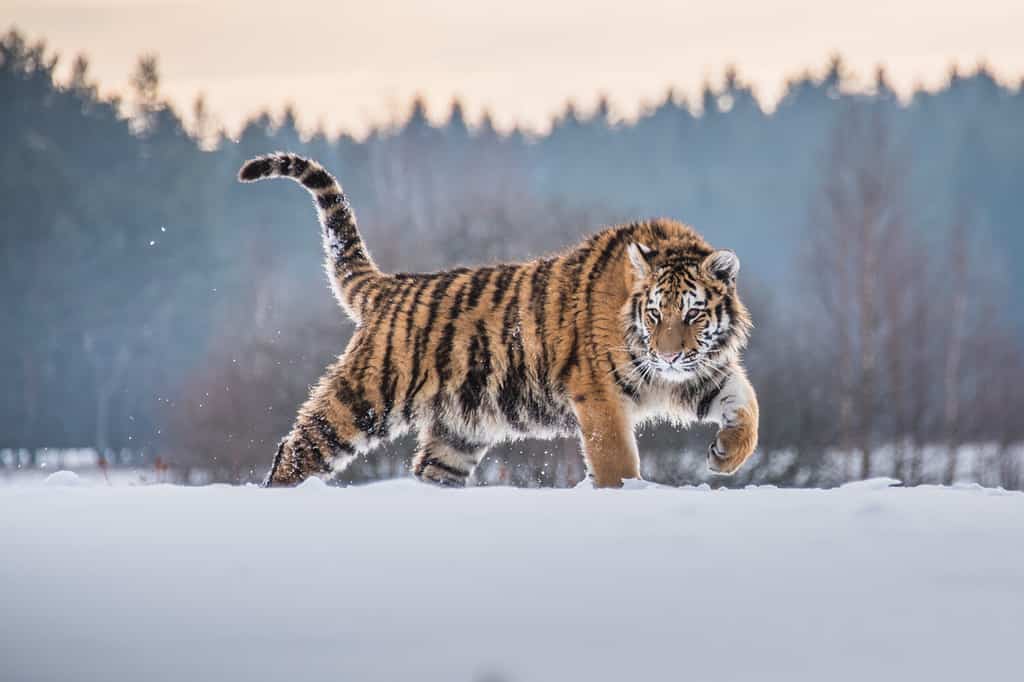The so-called big cats include many species and subspecies of dangerous mammals. Among them are tigers and lions, two animals that serve as apex predators in their regions. The Siberian tiger is the largest tiger of them all, and it is a big, powerful creature. How would it fare if it took a trip to Africa and took on the “King of the Jungle?’ Today, we’re holding a hypothetical battle between a Siberian tiger vs. a lion. You’ll learn how they’re similar, what sets them apart, and which one would dominate the other in combat.
Comparing a Siberian Tiger and a Lion

| Siberian Tiger | Lion | |
|---|---|---|
| Size | Weight: 220-770 lbs Length: 7-11 ft Height: 2.5-3.5 ft | Weight: 264 lbs – 550 lbs Length: 4.7 ft – 8.2ft Height: 3ft-3.9ft |
| Speed and Movement Type | – 40-50 mph – Galloping run – 20ft -25ft leap – Can swim well | – 35 mph – Potentially 40-50 mph when closing on foes |
| Defenses | – Massive size – Speed – Striped fur camouflage helps tigers blend into their surroundings. | – Stays with pride for safety in numbers – Relatively large size as a carnivore frightens away many enemies – Can quickly run away from enemies |
| Offensive Capabilities | – 1000 PSI bite power – 30 teeth total – 3-inch canines – 4-inch claws – Strong jaws that allow tigers to clamp down and suffocate prey – Tremendous muscle strength that helps them overwhelm prey | – Sharp claws can gash foes – Paw strikes can deliver a powerful, staggering blow – Strong biting power of 650 PSI- 1,000 PSI can splinter bones and tear prey open – Have four 2.7-inch canines that they use to grasp and suffocate prey. |
| Predatory Behavior | – Ambush predator – Stalks and attacks in favorable conditions – Seeks to clamp on prey’s neck to deliver a fatal bite. | – Endurance predator or ambush predator – Works as a group to take down prey – Ambush predators on small prey |
What Are Key Differences Between a Siberian Tiger and a Lion?

The majestic lion is the only one of the big cats to live in groups.
©iStock.com/Shawn Levin
The most significant differences between Siberian tigers and lions lie in their morphology and size. Siberian tigers are massive quadrupedal felines that weigh up to 770 lbs, measure 11 ft long, and grow 3.5 ft tall. They have short, striped fur that is the same length throughout their bodies and aids them with camouflage, a long tail, and a large head. Lions are large quadrupedal felines that weigh up to 550 lbs, measure 3.9 ft tall, and grow up to 8.2 ft long. Males, and some females, have manes that protect their necks from biting attacks. Their fur helps them blend into savannahs and scrublands, but they don’t have any unique patterns.
These differences aren’t that immense, but these cats have other differences like range. Yet, we’re going to stay focused on elements that are going to change the outcome of the fight. With that in mind, let’s take a closer look at what factors will play a role in the fight between a tiger and a lion.
What Are the Key Factors in a Fight Between a Siberian Tiger and a Lion?

Lions are ferocious hunters that use their size and tenacity to kill foes.
©Blue Slate Films/Shutterstock.com
The most significant factors in a battle between a Siberian tiger and a lion include their size, speed, defenses, offensive powers, and predatory behavior.
We’re going to examine each of these elements and see which mammal has the advantage in each section. By the time we’re done exploring each topic, we’ll know which of them has a better chance of survival.
Siberian Tiger vs Lion: Size
Siberian tigers are larger than lions. These tigers reach massive sizes of 770 lbs or more while measuring up to 11 ft long and standing 3.5 ft tall. Lions have a similar height to the Siberian tiger, but they only weigh up to 550 lbs and grow 8 ft long.
Siberian tigers have a size advantage.
Siberian Tiger vs Lion: Speed and Movement
Lions and Siberian tigers both move at similar speeds. On average, they can hit speeds in the 30 to 35 mph range. Yet, when they are pursuing foes, they can reach speeds between 40 and 50 mph for short distances.
Interestingly, both animals are known to launch into a leap at the end of their sprint when they have prey in their sights. They can leap about 25 feet, and lions can leap about 30 ft.
We’re going to call speed a tie in this case.
Siberian Tiger vs Lion: Defenses
Lions and tigers both have similar defenses. They count on their size to deter attackers, and they have limited forms of camouflage in their fur to help them blend into their environments. However, lions have something that tigers do not: a pride of fellow lions.
Generally speaking, lions have safety in numbers that tigers lack. In this fight, though, we are setting up a one-on-one match.
Tigers and lions are tied in defenses.
Siberian Tiger vs Lion: Offensive Capabilities
Lions are known for being very dangerous animals. They have speed and power in great amounts. A lion can use its sharp claws to gash foes, deliver a powerful paw swipe, and bite its prey to death. Lions have a biting power between 650 and 1,000 PSI, enough to break bones.
When you add their 2.7-inch canines into the mix, it’s easy to see what makes these mammals so deadly. They try to bite down on their prey’s neck, crushing vertebrae and suffocating their victims.
Siberian tigers are very similar in most respects. They have 4-inch sharp claws, a lot of power to put into swipes with their forelegs, and the ability to bite prey with 3-inch canines with 1,000 PSI of power. They also prefer to bite the neck of their prey to suffocate them or simply bite their heads for an instant kill.
All told, Siberian tigers and lions are tied in terms of their offensive capabilities.
Siberian Tiger vs Lion: Predatory Behavior
Lions are often considered ambush predators, and they are to a degree. However, they have differences from the tiger’s ambush. Lions will often lie in wait for prey to approach, often those animals lagging behind the rest, and then attack. Sometimes, they can kill the animal outright.
Other times, when the animal is too large, they use members of their pride to work together and bring it down. Thus, their ambush style is a mixture of the two, and they have mixed results. One thing is clear, though: lions are deadlier when they are working together like the Mapogo Lions.
Tigers are different. They are ambush predators that almost always hunt alone. They take down their prey from a stealthy ambush or give a short chase, mostly alone, when they are spotted. Essentially, Siberian tigers engage in a purer form of ambush predation.
Both animals have powerful predatory behaviors, but Siberian tigers are deadlier alone.
Who Would Win in a Fight Between a Siberian Tiger and a Lion?

The Siberian tiger would overwhelm the King of the Jungle.
©iStock.com/wrangel
A Siberian tiger would win a fight against a lion. Simply put, Siberian tigers are larger and more powerful than lions. Even though the two have many bodily attributes that are similar to each other, the tiger has more power behind their attacks and a better chance of ambushing the lion.
Even if the fight started in an arena with no ambush possible, the Siberian tiger would win. It has the size advantage to help them overwhelm the lion. The chances are good that this would be a bit of a hectic fight, though. Claws would tear flesh, and teeth would find their mark.
Eventually, the tiger would see its opening and clamp down on the lion’s head or neck, breaking their skull or suffocating them. The mane would offer some protection, but the brutal force of a Siberian tiger’s bite would still choke the life out of the lion.
Animals That Could Take Down a Siberian Tiger
While a Siberian tiger would be able to best a lion in a fight due to its larger size and power, it’s possible that a even larger and more powerful animal could take down a tiger.
The elephant is the largest land animal in the world and would win in a fight with a tiger. Although they share habitats in India and parts of Asia, the two species generally do not interact so a face-off would be a rare occurence.
An elephant can weigh more than 10,000 pounds, grow to 12 feet tall, and reach 21 feet long, so it would have the size advantage over a tiger. However a tiger has the superior speed as it’s able to reach a top speed of 40 mph, and has better senses, offensive capabilities and a bigger bite power with a force of 1,000 PSI. But in actual combat, an elephant would be able to shake off a tiger if it leaped onto its back and likely would knock the tiger over at some point. After that, all it would take is for part of the tiger’s body to be caught under the elephant and it would be crushed or stabbed to death. However, if the elephant was a baby or a juvenile, the tiger would probably be the victor.
Another animal that would be able to take down a tiger is a Kodiak bear, the world’s second-largest bear species. Again, size counts when it comes to a Siberian tiger vs. a Kodiak bear, with the bear capable of being twice as heavy, longer in body, and much taller than the tiger, by weighing more than 1,500 pounds, standing close to 5 feet tall at the shoulder and around 8 feet long. The bear has a large stocky body that protects it, with a thick layer of muscle and fat covering its vital organs and its fur providing an extra defensive layer. While the tiger again has the superior speed and offensive capabilities, and is a more deadly predator, ultimately in a battle the bear could use its ability to rear up on its hind legs to gain the advantage, bear down upon the tiger and end the fight by mauling it.
In a battle of a tiger vs. a polar bear, the tiger would also lose against the largest bear species in the world if it were two adult males fighting.
Bonus: Are Siberian Tigers Endangered?

Most of the Siberian tigers left in the world live in Russia.
©Vaclav Sebek/Shutterstock.com
Siberian tigers are the largest cats in the world – and differ from other tigers in appearance in two ways: their thick coats have fewer paler strips and they sport short manes to help them to stay warm in their colder habitats. How many of these majestic predators are left in the world today?
Most of the Siberian tigers left in the world today live in a small region in southeast Russia – with a few located in small numbers in North Korea and China. They are considered endangered by the IUCN’s Red List – with estimates of around 600 Siberian tigers living wild with a few hundred in captivity. Loss of habitat and poaching are reasons for their dwindling numbers – with many animals being illegally hunted for their fur and body parts that are used for medicinal purposes in some cultures.
The Siberian tiger was on the brink of extinction in the 1940s when only 40 were estimated to be in the wild. The Soviet Union brought in anti-poaching controls and established protected zones. Those efforts have led to the species going from nearly extinct with 40 tigers to endangered with 500 – 600 individuals.
The photo featured at the top of this post is © Volodymyr Burdiak/Shutterstock.com
Thank you for reading! Have some feedback for us? Contact the AZ Animals editorial team.






